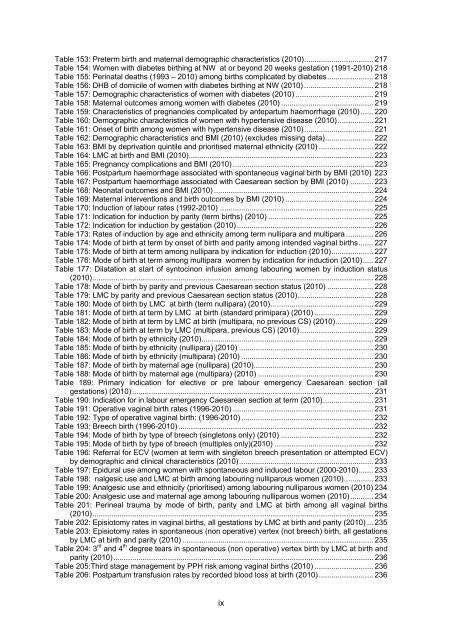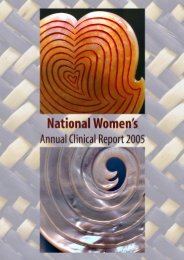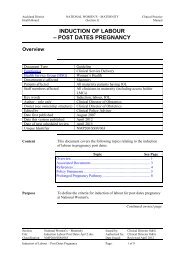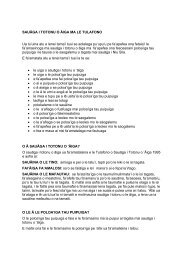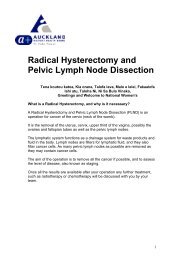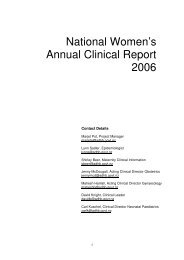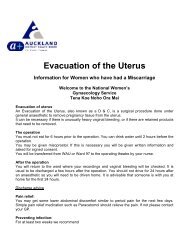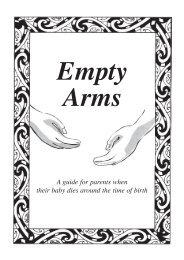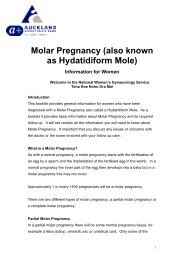National Women's Annual Clinical Report 2010
National Women's Annual Clinical Report 2010
National Women's Annual Clinical Report 2010
Create successful ePaper yourself
Turn your PDF publications into a flip-book with our unique Google optimized e-Paper software.
Table 153: Preterm birth and maternal demographic characteristics (<strong>2010</strong>)................................. 217<br />
Table 154: Women with diabetes birthing at NW at or beyond 20 weeks gestation (1991-<strong>2010</strong>) 218<br />
Table 155: Perinatal deaths (1993 – <strong>2010</strong>) among births complicated by diabetes...................... 218<br />
Table 156: DHB of domicile of women with diabetes birthing at NW (<strong>2010</strong>) ................................. 218<br />
Table 157: Demographic characteristics of women with diabetes (<strong>2010</strong>) ..................................... 219<br />
Table 158: Maternal outcomes among women with diabetes (<strong>2010</strong>) ............................................ 219<br />
Table 159: Characteristics of pregnancies complicated by antepartum haemorrhage (<strong>2010</strong>) ...... 220<br />
Table 160: Demographic characteristics of women with hypertensive disease (<strong>2010</strong>)................. 221<br />
Table 161: Onset of birth among women with hypertensive disease (<strong>2010</strong>)................................. 221<br />
Table 162: Demographic characteristics and BMI (<strong>2010</strong>) (excludes missing data)....................... 222<br />
Table 163: BMI by deprivation quintile and prioritised maternal ethnicity (<strong>2010</strong>) .......................... 222<br />
Table 164: LMC at birth and BMI (<strong>2010</strong>)........................................................................................ 223<br />
Table 165: Pregnancy complications and BMI (<strong>2010</strong>) ................................................................... 223<br />
Table 166: Postpartum haemorrhage associated with spontaneous vaginal birth by BMI (<strong>2010</strong>) 223<br />
Table 167: Postpartum haemorrhage associated with Caesarean section by BMI (<strong>2010</strong>) ........... 223<br />
Table 168: Neonatal outcomes and BMI (<strong>2010</strong>) ............................................................................ 224<br />
Table 169: Maternal interventions and birth outcomes by BMI (<strong>2010</strong>) .......................................... 224<br />
Table 170: Induction of labour rates (1992-<strong>2010</strong>) ......................................................................... 225<br />
Table 171: Indication for induction by parity (term births) (<strong>2010</strong>) .................................................. 225<br />
Table 172: Indication for induction by gestation (<strong>2010</strong>) ................................................................. 226<br />
Table 173: Rates of induction by age and ethnicity among term nullipara and multipara ............. 226<br />
Table 174: Mode of birth at term by onset of birth and parity among intended vaginal births....... 227<br />
Table 175: Mode of birth at term among nullipara by indication for induction (<strong>2010</strong>).................... 227<br />
Table 176: Mode of birth at term among multipara women by indication for induction (<strong>2010</strong>)..... 227<br />
Table 177: Dilatation at start of syntocinon infusion among labouring women by induction status<br />
(<strong>2010</strong>)...................................................................................................................................... 228<br />
Table 178: Mode of birth by parity and previous Caesarean section status (<strong>2010</strong>) ...................... 228<br />
Table 179: LMC by parity and previous Caesarean section status (<strong>2010</strong>).................................... 228<br />
Table 180: Mode of birth by LMC at birth (term nullipara) (<strong>2010</strong>)................................................. 229<br />
Table 181: Mode of birth at term by LMC at birth (standard primipara) (<strong>2010</strong>) ............................ 229<br />
Table 182: Mode of birth at term by LMC at birth (multipara, no previous CS) (<strong>2010</strong>).................. 229<br />
Table 183: Mode of birth at term by LMC (multipara, previous CS) (<strong>2010</strong>)................................... 229<br />
Table 184: Mode of birth by ethnicity (<strong>2010</strong>).................................................................................. 229<br />
Table 185: Mode of birth by ethnicity (nullipara) (<strong>2010</strong>) ................................................................ 230<br />
Table 186: Mode of birth by ethnicity (multipara) (<strong>2010</strong>) ............................................................... 230<br />
Table 187: Mode of birth by maternal age (nullipara) (<strong>2010</strong>)......................................................... 230<br />
Table 188: Mode of birth by maternal age (multipara) (<strong>2010</strong>) ....................................................... 230<br />
Table 189: Primary indication for elective or pre labour emergency Caesarean section (all<br />
gestations) (<strong>2010</strong>)................................................................................................................... 231<br />
Table 190: Indication for in labour emergency Caesarean section at term (<strong>2010</strong>)........................ 231<br />
Table 191: Operative vaginal birth rates (1996-<strong>2010</strong>) ................................................................... 231<br />
Table 192: Type of operative vaginal birth: (1996-<strong>2010</strong>) ............................................................... 232<br />
Table 193: Breech birth (1996-<strong>2010</strong>) ............................................................................................. 232<br />
Table 194: Mode of birth by type of breech (singletons only) (<strong>2010</strong>) ............................................ 232<br />
Table 195: Mode of birth by type of breech (multiples only)(<strong>2010</strong>) ............................................... 232<br />
Table 196: Referral for ECV (women at term with singleton breech presentation or attempted ECV)<br />
by demographic and clinical characteristics (<strong>2010</strong>)................................................................ 233<br />
Table 197: Epidural use among women with spontaneous and induced labour (2000-<strong>2010</strong>)....... 233<br />
Table 198: nalgesic use and LMC at birth among labouring nulliparous women (<strong>2010</strong>).............. 233<br />
Table 199: Analgesic use and ethnicity (prioritised) among labouring nulliparous women (<strong>2010</strong>) 234<br />
Table 200: Analgesic use and maternal age among labouring nulliparous women (<strong>2010</strong>)........... 234<br />
Table 201: Perineal trauma by mode of birth, parity and LMC at birth among all vaginal births<br />
(<strong>2010</strong>)...................................................................................................................................... 235<br />
Table 202: Episiotomy rates in vaginal births, all gestations by LMC at birth and parity (<strong>2010</strong>) ... 235<br />
Table 203: Episiotomy rates in spontaneous (non operative) vertex (not breech) birth, all gestations<br />
by LMC at birth and parity (<strong>2010</strong>) ........................................................................................... 235<br />
Table 204: 3 rd and 4 th degree tears in spontaneous (non operative) vertex birth by LMC at birth and<br />
parity (<strong>2010</strong>)............................................................................................................................ 236<br />
Table 205:Third stage management by PPH risk among vaginal births (<strong>2010</strong>) ............................ 236<br />
Table 206: Postpartum transfusion rates by recorded blood loss at birth (<strong>2010</strong>).......................... 236<br />
ix


